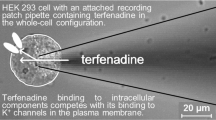Abstract
To elucidate the β-cytotropic effect of imidazoline compounds their inhibitory effect on ATP-dependent K+ channels (KATP channels) in pancreatic B-cells was compared with their binding to membranes from insulin-secreting HIT T15 cells. KATP channels in inside-out patches from B-cells were closed with the following rank order of efficacy at 10 μM: guanabenz > phentolamine = alinidine > clonidine > idazoxan > rilmenidine = amiloride. The last four compounds achieved an incomplete inhibition only. In contrast to sulfonylureas, the inhibitory action of imidazolines was not enhanced by ADP. With intact cells the site which mediates inhibition is less easily accessible for protonated compounds, suggesting a location at the inner face of the plasma membrane. Competition binding experiments were performed by masking α-adrenoceptors and using [3H]clonidine as ligand. Homologous displacement of [3H]clonidine revealed two distinct binding sites in HIT cell membranes characterized by dissociation constants of 38 nM and 4,911 nM and maximal binding capacities of 118 fmol/mg protein and 18 pmol/ mg protein. Generally, ligands for I2 imidazoline receptors were more potent than ligands for I1 imidazoline receptors to displace [3H]clonidine from the high affinity site, which does not fit into the current classification of imidazoline receptors. Binding to the second site had affinities in the micromolar range, similar to the concentrations necessary to inhibit KATP channels in B-cells. However, alinidine and phentolamine inhibited KATP channels already at concentrations at which they displaced [3H] clonidine only from the high affinity site, but not yet from the low affinity site. Since the proportion of the low and high affinity site varied in dependence of the competitor, the imidazoline binding sites in HIT cells may not be independent, but may rather represent two interacting or interconvertible sites both of which may be involved in KATP channel closure.
Similar content being viewed by others
Author information
Authors and Affiliations
Additional information
Received: 1 April 1997 / Accepted: 2 June 1997
Rights and permissions
About this article
Cite this article
Rustenbeck, I., Herrmann, C., Ratzka, P. et al. Imidazoline/guanidinium binding sites and their relation to inhibition of KATP channels in pancreatic B-cells. Naunyn-Schmiedeberg's Arch Pharmacol 356, 410–417 (1997). https://doi.org/10.1007/PL00005070
Issue Date:
DOI: https://doi.org/10.1007/PL00005070




